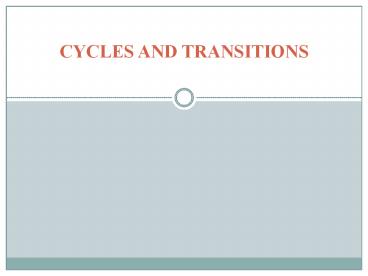CYCLES AND TRANSITIONS - PowerPoint PPT Presentation
Title:
CYCLES AND TRANSITIONS
Description:
cycles and transitions – PowerPoint PPT presentation
Number of Views:76
Avg rating:3.0/5.0
Title: CYCLES AND TRANSITIONS
1
CYCLES AND TRANSITIONS
2
READING
- Smith, Democracy, Introduction chs. 1-2, 4
- Modern Latin America, chs. 3, 5 (Mexico, Cuba)
- Magaloni, Demise of Mexicos One-Party Regime
3
OUTLINE
- Concepts of democracy
- Electoral variations
- Transitions, To and Fro
- Case Studies Cuba and Mexico
- Caveats, Causes, and Codas
4
KEY QUESTIONS
- What explains the spread of democracy in Latin
America? Given authoritarian past? - What kind of democracy? What quality?
- Whats new about the current phase of democratic
change? How does it compare to prior periods? - What role (if any) for the United States?
- What implications for U.S. relations with Latin
America?
5
Concepts of Democracy
6
DEFINING PRINCIPLES
- Participation, such that no substantial segment
of the population is excluded from the effective
pursuit of political power - Competition, such that there are free, fair, and
regular contests for gaining support from the
populace - Accountability, such that political rulers and
elected representatives serve as agents of
their constituents and must justify their actions
and decisions in order to remain in office.
7
INSTITUTIONAL GUARANTEES
- Freedom to form and join organizations
- Freedom of expression
- The right to vote
- Eligibility for public office
- The right of political leaders to compete for
support and votes - Alternative sources of information
- Free and fair elections
- Institutions for making government policies
depend on elections and other expressions of
popular preference.
8
TWO KEY DIMENSIONS
- Elections
- Items 3-5, 7-8
- Rights
- Items 1-2, 6
- missing rule of law
- Question What if they dont go together? What
about the prospect of illiberal democracy?
9
Electoral Variations
10
CATEGORIES OF ELECTORAL REGIMES
- Electoral democracy free and fair elections
- Semidemocracy elections free but not fair or,
effective power not vested in winner of elections - Competitive oligarchy elections fair but not
free candidates restricted to socio-economic
elite and suffrage restricted to minority of
population - Autocracy/authoritarianism no elections, or
elections neither free nor fair.
11
(No Transcript)
12
(No Transcript)
13
(No Transcript)
14
(No Transcript)
15
Transitions, To and Fro
16
DETERMINANTS OF DEMOCRATIC TRANSITIONS DOMESTIC
FACTORS
- Economic Development
- Social Forces/Class Coalitions
- Authoritarian Failures
- Elite Splits, Exclusions, and Negotiations of
Compacts with Opposition - Unsolvable Problems and the Search for Exits
17
DETERMINANTS OF DEMOCRATIC TRANSITIONS
INTERNATIONAL FACTORS
- 1. Imperialism and Democracy
- 2. Anti-Communist Crusades
- 3. Optimism and Uncertainty The 1990s
- 4. Now 9/11 and Its Aftermath
18
Types of Authoritarian Regime ________________
Power Structure___________________
Personalist Institutionalized Leadership ______
______ Traditional Caudillo
or Collective Junta or Military Man on
Horseback Bureaucratic-Authoritarian Regim
e Technocratic State, One-Party State
or Civilian Delegative Semi-Democracy, Corporatis
t Regime or Sultanistic Despotism
19
FORMS OF TRANSITION
- Personalist regimes, especially sultanistic
despotism armed revolution - Personalist regimes if military armed
revolution or military replacement - Bureaucratic regimes fissures within ruling
elite, negotiation with opposition - One-party regimes winning elections
20
CASE STUDIES CUBA AND MEXICO
- Cuba (1959) armed revolution (against weak
state, corrupt regime, incompetent military,
withdrawal of U.S. support) - Mexico (1910) disputed election armed
revolution incomplete replacement of leadership - Mexico (2000) victory at polls
21
DEMISE OF THE PRI
- Decline from hegemony to dominance
- Splits within elite (1980s)
- Economic problems and policies (NAFTA)
- Deterioration of party base, strengthening of
opposition ( Zapatista uprising) - Institutional reforms
- 1990-93 piecemeal change
- 1994-96 independent IFE
22
PRI PREFERENCES PAYOFFS
- Preferences
- The PRI prefers winning to losing and having a
submissive electoral institute to an independent
IFE and prefers the Opposition to accept the
election results rather than contest them because
this entails legitimacy costs. - Payoffs
- Winning 10
- Creating IFE - 2
- Fraud - 2
- Challenge - 4
23
OPPOSITION PREFER PAYOFFS
- Preferences
- The Opposition prefers winning to losing it
prefers an independent IFE and it makes its
decision to accept or contest contingent on the
PRIs choice to create an independent IFE or
not. - Payoffs
- Winning 10
- Independent IFE 2
- Losing/fraud - 4
- Contesting/Strong IFE - 2
- Contesting/Submissive IFE 2
24
(No Transcript)
25
Caveats, Causes and Codas
26
Caveat No. 1
- On the importance of defining terms
- Electoral democracy (Smith others)
- Liberal democracy (Smith others) Robert Dahl
democracy - Illiberal democracy (Smith Zakaria)
- Nondemocracy (Smith) Authoritarianism
27
Caveat No. 2
- On choice of terms
- Wave vs. cycle
- Implicit causal mechanisms
- On Latin America in world context
- Understanding pre-1950s
- Singular profile among developing areas
- Roles of ideology/culture
28
Caveat No. 3
- A weak state is a weak democracy
- Taming of democracy vs. incompetent governance
- Democracy by permission
- And then the rise of the new left
29
Caveat No. 4
- Outcomes of Political Transitions, 1900-2000
- 1900-1939 1940-1977 1978-2000 1900-2000
- ___ ___ _______ ___ ___ _______
- Outcome____
- Autocracy 45 47
17 39 - Oligarchy 36 6
-- 15 - Semidemocracy 11 20
40 22 - Democracy 9 27 43
24 - N transitions 56 64
35 155
30
Caveat No. 5
- How to understand the return of the PRI?
- PRI 39.2
- PRD 32.4
- PAN 26.1
- New 2.3
- Is it the same party?
- Was it a PRI victory? Or losses by other
parties? - What might have happened with a MRO?
- Does this mean consolidation?































